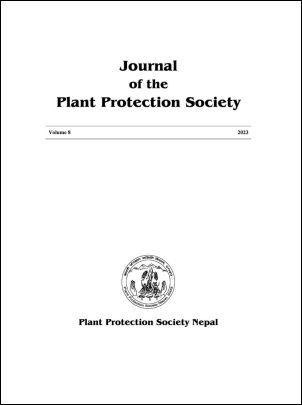Management of Crown and Root Rot Caused by Rhizoctonia solani in Acid Lime (Citrus aurantifolia) under Screen House Conditions in Kirtipur, Kathmandu
DOI:
https://doi.org/10.3126/jpps.v8i1.56449Keywords:
Carbendazim, pathogenicity, reduction, Rhizoctonia solaniAbstract
Crown and root rot disease was among the major problems in acid lime (Citrus aurantifolia) seedlings grown in the nursery of Warm Temperate Horticulture Centre, Kirtipur, Nepal. Samples of the diseased plants were investigated at the laboratory of Nepal Plant Disease and Agro Associates. Rhizoctonia solani, Fusarium solani and Alternaria citri were found associated with the disease samples. On pathogenicity testing R. solani showed symptoms like those of the infected seedlings. Hence, a pot experiment was conducted in a completely randomized design with four replications to manage the disease. Acid lime seedlings grown in sterilized soil and inoculum of R. solani prepared in potato dextrose agar (PDA) were used for the experiment. The treatments included carbendazim 50WP @ 1000 ppm, Trichoderma viride @ 2 ml/l water, Pseudomonas fluorescens @ 2 ml/l water, A-arya 009 (essential oil and organic acids) @ 1 ml/l water, and control (water) which were applied by soil drenching before 15 days of pathogen inoculation. Carbendazim at 100 and 200 ppm was also evaluated against R. solani by poison food technique on PDA. In the pot culture, the effect of treatments was significant on the growth of root and shoot of seedlings and both disease incidence and severity. Carbendazim had significantly least disease incidence (43.75%) and least disease severity (18.75%) among the treatments 45 days after inoculation with the pathogen. Also, the fungicide at 100 ppm gave complete inhibition of R. solani in PDA culture. Hence, carbendazim could be suggested for the management of the citrus crown and root rot caused by R. solani. However, further study is required to find out appropriate concentration of the fungicide for effective management of disease.
Downloads
Downloads
Published
How to Cite
Issue
Section
License

This work is licensed under a Creative Commons Attribution-NonCommercial 4.0 International License.
This license enables reusers to distribute, remix, adapt, and build upon the material in any medium or format for noncommercial purposes only, and only so long as attribution is given to the creator.

